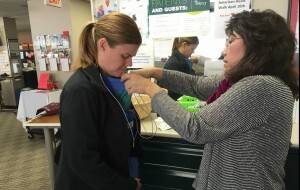Yes, a Heart Attack Can Happen to You!
Guest blog post by Melissa Murphy
Half marathon, check. Workout 45 minutes everyday, check. Eat healthy, check. No family history of heart disease, check. Heart attack, check!
If you are like me, you would scratch your head to hear someone in her early 40’s suffered a heart attack. That, of course, happens to people that are much older or who have risk factors like smoking, obesity or high cholesterol. I’m proud to say that I don’t fall into any of those categories, but the truth is, I now will live with heart disease the rest of my life.
Here is an excerpt of a blog I wrote about my heart attack:
It started as a normal day. I exercised in the moring, got the kids to school and went to work. After school we ran around and did our normal daily routines. I took [my daughter] Brenna to Irish dance lessons. We had supper and all went to bed. At 2:00 am I woke up with crushing chest pain. First thought, “I gave up caffeine today for Lent. Could that be the cause? What if I’m having indigestion?!”
I got up and walked to the coach and sat in the dark for a minute. By now, I’m noticing the pain is in my jaw. I finally start to acknowledge that this is something bigger than I could possibly imagine. I have a Bachelors in Nursing and remember from my training that women present differently than men. (You can read more about the night I suffered a hearth attack and follow my road to recovery here: http://pinnie40.blogspot.com)
February ushers in National “Go Red for Women,” which brings awareness of heart disease and stroke by asking people to wear red and get more informed. The one thing I would like readers to know is how women’s symptoms can be completely different from men’s symptoms.
In my case, years of estrogen supplements from birth control pills caused a rare dissection in
my right coronary artery. I had two stents placed to reinforce the wall of my artery. Those stents will be a part of me for life, and I even received a serial number certificate (to show to doctors during procedures) as a reminder. I’ve also gone from one daily medication to a daily pill box with four medications. These medications will be my lifeline for the rest of my life, helping to guard against cholesterol and blood clots that could cause another heart attack.
Ladies and gentlemen, this is where it gets real. It – Can – Happen – To – You!!! Even though I’m a nurse and should’ve known better, I spent precious time googling my symptoms thinking it had to be something else. Don’t let death be the result of being embarrassed to call an ambulance. I delayed in making the 911 call and my vitals crashed in the ambulance on the way to the hospital.
Below are a list of symptoms that you should take seriously:
- Chest pain or discomfort (may not be on left side)
- Pain in your arm, back, neck and jaw
- Stomach pain
- Shortness of breath, nausea and light headedness
- Sweating
- Fatigue
Many women will experience vague or silent symptoms that might simply go unnoticed. Flu, indigestion, jaw pain, chest pain and shortness of breath are all signs of a heart attack. I had chest pain, jaw pain and felt nauseated. But I was still able to have a conversation, Google symptoms and doubt what was really going on. Sadly, all the symptoms aren’t always present. Be aware and take multiple symptoms seriously.
My other advice is to have discussions with your doctors. If you fall in the risk groups, work with your care providers and family members to improve your health. It might seem like hard work now, but the reward will be many years ahead with loved ones.
NOTE: One way to improve overall health is to meal plan. Registered Dietician Anne Hytrek of the Ankeny Prairie Trails Hy-Vee, an advisory board member for the Iowa Food & Family Project, shares tips for creating heart healthy meals and choosing healthy snacks. There are so many great sources for heart healthy recipes!
Today Melissa is sharing one of her favorite recipes from Healthy Recipes for Your Heart. Reprinted with permission Copyright © 2016 by the American Heart Association. Available on ShopHeart.org, while supplies last!
Tortilla Soup with Grilled Chicken
Ingredients
This version of a popular Mexican soup offers the same great flavor with less sodium. ¡Muy delicioso!
- 168 Calories for serving size of 1 ¼ cups (this recipe serves 4)
- 288 mg Sodium
- Click here for additional nutritional information.
Ingredients:
- Cooking spray
- 2, 6-inch corn tortillas cut into ¼ inch-wide strips
- 2 cups fat-free, low-sodium chicken broth
- 2 cups water
- 8 oz. canned, no-salt-added tomato sauce
- 6 oz. cubed, skinless grilled chicken breast (Cook without salt and discard all visible fat)
- 1 small yellow summer squash (about 4 ounces), diced
- 1 small zucchini (about 4 ounces), diced
- 1/2 cup frozen whole-kernel corn
- 1 tsp. salt-free, all-purpose seasoning blend
- 1 tsp. chili powder
- 1 tsp. onion powder
- 1 tsp. olive oil
- 1/2 tsp. ground cumin
- 1/4 tsp. dried oregano, crumbled
- 1/4 tsp. salt
- 1/4 cup shredded, low-fat Cheddar cheese
Instructions
Directions
- Preheat the oven to 350°F. Lightly spray a baking sheet with cooking spray. Arrange the tortilla strips in a single layer on the baking sheet. Lightly spray with cooking spray.
- Bake for 10 minutes or until crisp.
- Meanwhile, in a medium saucepan, bring the remaining ingredients except the Cheddar to a simmer over medium-high heat. Reduce the heat and simmer, covered, for about 15 minutes. Just before serving, sprinkle the soup with the tortilla strips and Cheddar.

